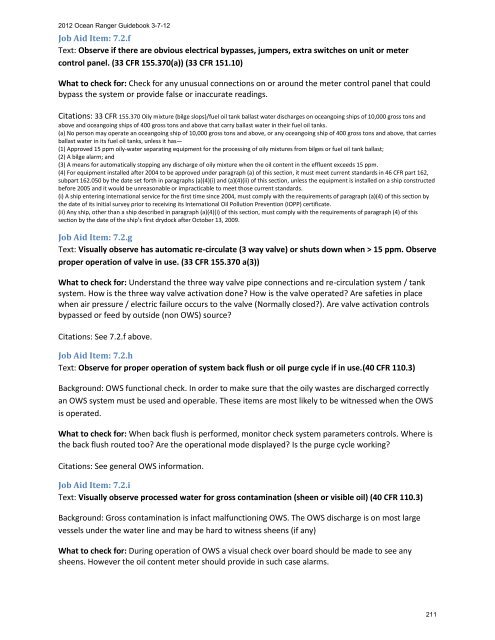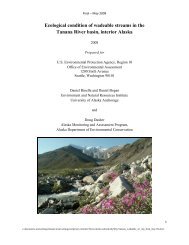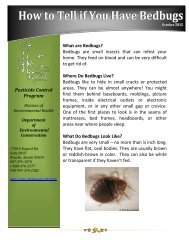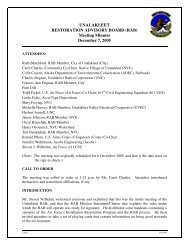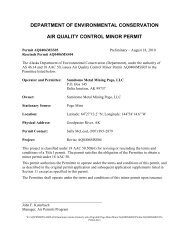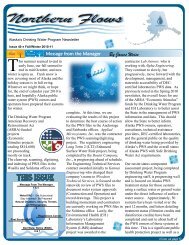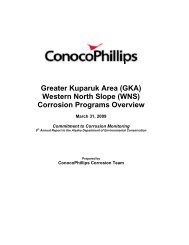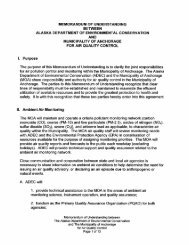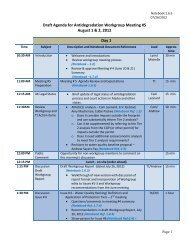2012 Ocean Ranger Guidebook Revision 3-7-12 - Alaska ...
2012 Ocean Ranger Guidebook Revision 3-7-12 - Alaska ...
2012 Ocean Ranger Guidebook Revision 3-7-12 - Alaska ...
You also want an ePaper? Increase the reach of your titles
YUMPU automatically turns print PDFs into web optimized ePapers that Google loves.
<strong>20<strong>12</strong></strong> <strong>Ocean</strong> <strong>Ranger</strong> <strong>Guidebook</strong> 3-7-<strong>12</strong><br />
Job Aid Item: 7.2.f<br />
Text: Observe if there are obvious electrical bypasses, jumpers, extra switches on unit or meter<br />
control panel. (33 CFR 155.370(a)) (33 CFR 151.10)<br />
What to check for: Check for any unusual connections on or around the meter control panel that could<br />
bypass the system or provide false or inaccurate readings.<br />
Citations: 33 CFR 155.370 Oily mixture (bilge slops)/fuel oil tank ballast water discharges on oceangoing ships of 10,000 gross tons and<br />
above and oceangoing ships of 400 gross tons and above that carry ballast water in their fuel oil tanks.<br />
(a) No person may operate an oceangoing ship of 10,000 gross tons and above, or any oceangoing ship of 400 gross tons and above, that carries<br />
ballast water in its fuel oil tanks, unless it has—<br />
(1) Approved 15 ppm oily-water separating equipment for the processing of oily mixtures from bilges or fuel oil tank ballast;<br />
(2) A bilge alarm; and<br />
(3) A means for automatically stopping any discharge of oily mixture when the oil content in the effluent exceeds 15 ppm.<br />
(4) For equipment installed after 2004 to be approved under paragraph (a) of this section, it must meet current standards in 46 CFR part 162,<br />
subpart 162.050 by the date set forth in paragraphs (a)(4)(i) and (a)(4)(ii) of this section, unless the equipment is installed on a ship constructed<br />
before 2005 and it would be unreasonable or impracticable to meet those current standards.<br />
(i) A ship entering international service for the first time since 2004, must comply with the requirements of paragraph (a)(4) of this section by<br />
the date of its initial survey prior to receiving its International Oil Pollution Prevention (IOPP) certificate.<br />
(ii) Any ship, other than a ship described in paragraph (a)(4)(i) of this section, must comply with the requirements of paragraph (4) of this<br />
section by the date of the ship’s first drydock after October 13, 2009.<br />
Job Aid Item: 7.2.g<br />
Text: Visually observe has automatic re-circulate (3 way valve) or shuts down when > 15 ppm. Observe<br />
proper operation of valve in use. (33 CFR 155.370 a(3))<br />
What to check for: Understand the three way valve pipe connections and re-circulation system / tank<br />
system. How is the three way valve activation done? How is the valve operated? Are safeties in place<br />
when air pressure / electric failure occurs to the valve (Normally closed?). Are valve activation controls<br />
bypassed or feed by outside (non OWS) source?<br />
Citations: See 7.2.f above.<br />
Job Aid Item: 7.2.h<br />
Text: Observe for proper operation of system back flush or oil purge cycle if in use.(40 CFR 110.3)<br />
Background: OWS functional check. In order to make sure that the oily wastes are discharged correctly<br />
an OWS system must be used and operable. These items are most likely to be witnessed when the OWS<br />
is operated.<br />
What to check for: When back flush is performed, monitor check system parameters controls. Where is<br />
the back flush routed too? Are the operational mode displayed? Is the purge cycle working?<br />
Citations: See general OWS information.<br />
Job Aid Item: 7.2.i<br />
Text: Visually observe processed water for gross contamination (sheen or visible oil) (40 CFR 110.3)<br />
Background: Gross contamination is infact malfunctioning OWS. The OWS discharge is on most large<br />
vessels under the water line and may be hard to witness sheens (if any)<br />
What to check for: During operation of OWS a visual check over board should be made to see any<br />
sheens. However the oil content meter should provide in such case alarms.<br />
211


